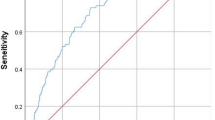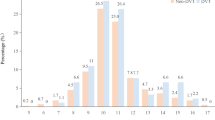Abstract
Objective
Deep venous thrombosis (DVT) is a common complication in patients with spinal fractures caused by high-energy injuries. Early identification of patients at high risk of postoperative DVT is essential for the prevention of thrombosis. This study aimed to develop and validate a prediction model based on a nomogram to predict DVT in patients with spinal fractures caused by high-energy injuries.
Methods
Clinical data were collected from 936 patients admitted to our hospital between January 2016 and December 2021 with spinal fractures caused by high-energy injuries. Multivariate logistic regression analysis was used to identify the risk factors for postoperative DVT and to develop a nomogram. The predictive performance of the nomogram was evaluated by the receiver operating characteristic (ROC) curve and calibration curve.
Results
The incidence of preoperative DVT was 15.38% (144/936). The postoperative incidence of DVT was 20.5% (192/936). The multivariate analysis revealed that age, operation time, blood transfusion, duration of bed rest, American Spinal Injury Association (ASIA) score and D-dimer were risk factors for postoperative DVT. The area under the ROC curve of the nomogram was 0.835 and the calibration curve showed good calibration.
Conclusions
The nomogram showed a good ability to predict postoperative DVT in patients with spinal fractures caused by high-energy injuries, which may benefit pre- and postoperative DVT prophylaxis strategy development.



Similar content being viewed by others
References
Saglam N, Dogan S, Ozcan C et al (2019) Comparison of four different posterior screw fixation techniques for the treatment of thoracolumbar junction fractures.World Neurosurg 123:773–780
Liu B, Zhu Y, Liu S et al (2018) National incidence of traumatic spinal fractures in China: data from china national fracture study. Medicine (Baltimore) 97(35):e12190
Niikura T, Sakai Y, Lee SY et al (2015) D-dimer levels to screen for venous thromboembolism in patients with fractures caused by high-energy injuries. J Orthop Sci 20(4):682–688
den Ouden LP, Smits AJ, Stadhouder A et al (2019) Epidemiology of spinal fractures in a level one trauma center in the Netherlands: a 10 years review. Spine 44(10):732–739
Baaj AA, Downes K, Vaccaro AR et al (2011) Trends in the treatment of lumbar spine fractures in the United States: a socioeconomics perspective: clinical article. J Neurosurg Spine 15:367–370
Meissner MH, Chandler WL, Elliott JS (2003) Venous thromboembolism in trauma: a local manifestation of systemic hypercoagulability? J Trauma 54(2):224–231
Rogers FB, Cipolle MD, Velmahos G et al (2002) Practice management guidelines for the prevention of venous thromboembolism in trauma patients: the EAST practice management guidelines work group. J Trauma 53(1):142–164
Sumislawski JJ, Kornblith LZ, Conroy AS et al (2018) Dynamic coagulability after injury: Is delaying venous thromboembolism chemoprophylaxis worth the wait? J Trauma Acute Care Surg 85(5):907–914
Taghlabi K, Carlson BB, Bunch J et al (2022) Chemoprophylactic anticoagulation 72 hours after spinal fracture surgical treatment decreases venous thromboembolic events without increasing surgical complications. N Am Spine Soc J 11:100141
Wolberg AS, Rosendaal FR, Weitz JI et al (2015) Venous thrombosis. Nat Rev Dis Primers 7(1):15006
Duffett L (2022) Deep venous thrombosis. Ann Intern Med 175(9):129–144
Lin Z, Mi B, Liu X et al (2021) Nomogram for predicting deep venous thrombosis in lower extremity fractures. Biomed Res Int 2021:9930524
Ma J, Du P, Qin J et al (2021) Incidence and risk factors predicting deep venous thrombosis of lower extremity following spinal fractures. Sci Rep 11(1):2441
Lv B, Wang H, Li W et al (2022) Admission prevalence and risk factors of deep vein thrombosis in patients with spinal cord injury complicated with cervical fractures. Clin Appl Thromb Hemost 28:10760296221108968
Wang S, Wu L (2022) Risk factors for venous thrombosis after spinal surgery: a systematic review and meta-analysis. Comput Math Methods Med 2022:1621106
Ma J, Qin J, Shang M et al (2022) Incidence and risk factors of preoperative deep venous thrombosis in closed tibial shaft fracture: a prospective cohort study. Arch Orthop Trauma Surg 142(2):247–253
Jiang P, Yang D, Chang B et al (2022) Efficacy of anterior-posterior decompression on thoracolumbar spine fracture with spinal cord injury and analysis of risk factors for postoperative deep vein thrombosis. Am J Transl Res 14(6):4033–4041
Silveira PC, Ip IK, Goldhaber SZ et al (2015) Performance of wells score for deep vein thrombosis in the inpatient setting. JAMA Intern Med 175(7):1112–1117
Krauss ES, Segal A, Cronin M et al (2019) Implementation and validation of the 2013 caprini score for risk stratification of arthroplasty patients in the prevention of venous thrombosis. Clin Appl Thromb Hemost 25:1076029619838066
Ruskin KJ (2018) Deep vein thrombosis and venous thromboembolism in trauma. Curr Opin Anaesthesiol 31(2):215–218
Peng G, Wang Q, Sun H et al (2021) Development and prospective validation of a novel risk score for predicting the risk of lower extremity deep vein thrombosis among multiple trauma patients. Thromb Res 201:116–122
Zhang L, Cao H, Chen Y et al (2020) Risk factors for venous thromboembolism following spinal surgery: a meta-analysis. Medicine (Baltimore) 99(29):e20954
Li Q, Chen X, Wang Y et al (2018) Analysis of the occurrence of deep venous thrombosis in lower extremity fractures: a clinical study. Pak J Med Sci 34(4):828–832
Yan Y, Zhang B, Yang J et al (2021) The perioperative deep vein thrombosis in lower extremities in patients with pelvic fracture: a case–control study. Clin Appl Thromb Hemost 27:10760296211033024
Jiang T, Song K, Yao Y et al (2019) Perioperative allogenic blood transfusion increases the incidence of postoperative deep vein thrombosis in total knee and hip arthroplasty. J Orthop Surg Res 14:235
Goel R, Patel EU, Cushing MM et al (2018) Association of perioperative red blood cell transfusions with venous thromboembolism in a north American registry. JAMA Surg 153:826–833
Cao J, Li S, Ma Y et al (2021) Risk factors associated with deep venous thrombosis in patients with different bed-rest durations: a multi-institutional case–control study. Int J Nurs Stud 114:103825
Ke L, Cui S, Chen S et al (2020) Dynamics of D-dimer in non-small cell lung cancer patients receiving radical surgery and its association with postoperative venous thromboembolism. Thorac Cancer 11:2483–2492
Rogers FB, Shackford SR, Horst MA et al (2012) Determining venous thromboembolic risk assessment for patients with trauma: the Trauma Embolic Scoring System. J Trauma Acute Care Surg 73(2):511–515
Bahl V, Hu HM, Henke PK et al (2010) A validation study of a retrospective venous thromboembolism risk scoring method. Ann Surg 251(2):344–350
Cheng X, Lei X, Wu H et al (2022) Development and validation of a predictive nomogram for preoperative deep vein thrombosis (DVT) in isolated calcaneal fracture. Sci Rep 12(1):5923
Funding
This work was supported by the Baoding Science and Technology Bureau project (Grant number 2041ZF100).
Author information
Authors and Affiliations
Corresponding author
Ethics declarations
Conflict of interest
The author (s) declared no potential conflicts of interest with respect to the research, authorship, and/or publication of this article.
Ethical approval
The Ethics Committee of Baoding No.1 Central Hospital approved this study.
Informed consent
Informed consent for our study was obtained from all patients.
Additional information
Publisher's Note
Springer Nature remains neutral with regard to jurisdictional claims in published maps and institutional affiliations.
Rights and permissions
Springer Nature or its licensor (e.g. a society or other partner) holds exclusive rights to this article under a publishing agreement with the author(s) or other rightsholder(s); author self-archiving of the accepted manuscript version of this article is solely governed by the terms of such publishing agreement and applicable law.
About this article
Cite this article
Lv, B., Wang, H., Zhang, Z. et al. Nomogram for predicting postoperative deep vein thrombosis in patients with spinal fractures caused by high-energy injuries. Arch Orthop Trauma Surg 144, 171–177 (2024). https://doi.org/10.1007/s00402-023-05085-5
Received:
Accepted:
Published:
Issue Date:
DOI: https://doi.org/10.1007/s00402-023-05085-5




